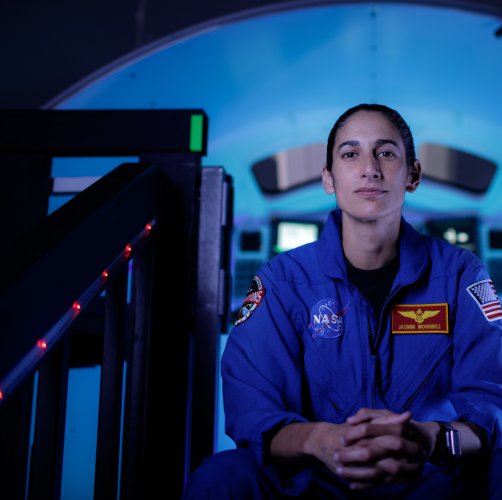1 of 3 | NASA Administrator Jim Bridenstine (C) gets a tour of the B-2 Test Stand on a work platform between the four RS-25 engines of the first core stage of the agency’s Space Launch System rocket at the Stennis Space Center near Bay St. Louis early lat year. File Photo by Joel Kowsky/NASA
ORLANDO, Fla., Dec. 28 (UPI) -- The handoff from Donald Trump's administration to that of Joe Biden, and a lack of congressional funding, have cast doubt on NASA's goal for a lunar landing by 2024 -- a date that already had been seen as unlikely.
"We can say, really, it's impossible at this point to meet that 2024 goal," said Casey Dreier, chief advocate for The Planetary Society, which says it is the largest nonprofit in the world to support space exploration.
"The issue is funding for NASA in general. Even the Trump White House cut NASA's funding in the first couple of years," said Dreier, who also is the society's senior space policy adviser.
NASA had been aiming for a 2028 moon landing. But Vice President Mike Pence advanced that by four years in a March 2019 address to the National Space Council in which he cited growing competition with China as a key reason.
"I'd say it's unlikely that the Biden Administration will stick with the goal of 2024, given the funding issues," Dreier said.
He added: "That doesn't mean the moon will fall out of favor. The Democratic Party platform endorses a moon to Mars program. It will just take a little longer."
In 2019, Congress cut NASA's funding request for $1 billion to build a human landing system to $600,000 for 2020. This fiscal year, the agency sought $3.2 billion for the landing system, but the final amount in the congressional bill is $850 million.
While NASA Administrator Jim Bridenstine has expressed confidence about getting to the moon by 2024, he frequently warned that politics was the biggest obstacle. Bridenstine will step down Jan. 20, the day of Biden's inauguration. No new administrator has been named.
The return to the moon is seen as a step toward Mars under NASA's Artemis program. The first mission, an uncrewed launch on a new rocket, SLS, is scheduled for November.
But NASA is behind schedule on testing that rocket's core stage, after 2020 delays that included a brief shutdown of work due to the coronavirus pandemic and hurricanes passing near the B-2 Test Stand at the agency's Stennis Space Center near Bay St. Louis, Miss.
NASA had planned to ship the core stage to Kennedy Space Center in Florida last month for final assembly with boosters and a capsule, but that step was delayed by the testing.
"We're getting to a point where we've got very little margin left in the schedule relative to our commitment to our delivery date," John Honeycutt, NASA's program manager on the rocket, said during a press conference Dec. 9.
NASA had halted testing of the rocket on the day of that press conference, after discovering a problem with loading of liquid oxygen propellant leading to a test firing. An investigation into the problem left the upcoming schedule in limbo.
The second Artemis mission would be a crewed flight of the SLS rocket around the moon, planned for 2023.
Biden talks about the benefits of space exploration for science and humanity, but hasn't specifically mentioned landing on the moon as much as Trump or Pence did, said Amy Foster, a professor of space history at the University of Central Florida.
"Political will is what is missing," Foster said. "But it's not just about presidential leadership. It's also about getting all the moving parts funded.
Planning for moon missions is far enough along that it will happen, Foster said, but the date is likely to slip.
"In the '60s, [President John F.] Kennedy announced the moonshot because he needed a political win, and the Cold War space race made it urgent, but it's not that urgent today," Foster said.
"I think we got to the moon less because of Kennedy saying it and more so because he died, and Johnson said we have to preserve his legacy."
NASA has selected 18 astronauts, nine men and nine women, for its Artemis Team of potential moonwalkers. The space agency expects one of them to become the first woman to walk on the moon, while another will be the first man to return to the moon since 1972.
Jasmin Moghbeli
Moghbeli poses for a portrait in the Systems Engineering Simulator for the International Space Station and advanced spaceflight programs at the Johnson Space Center on July 9, 2019. She will train for the moon mission. Photo by Bill Ingalls/NASA
















